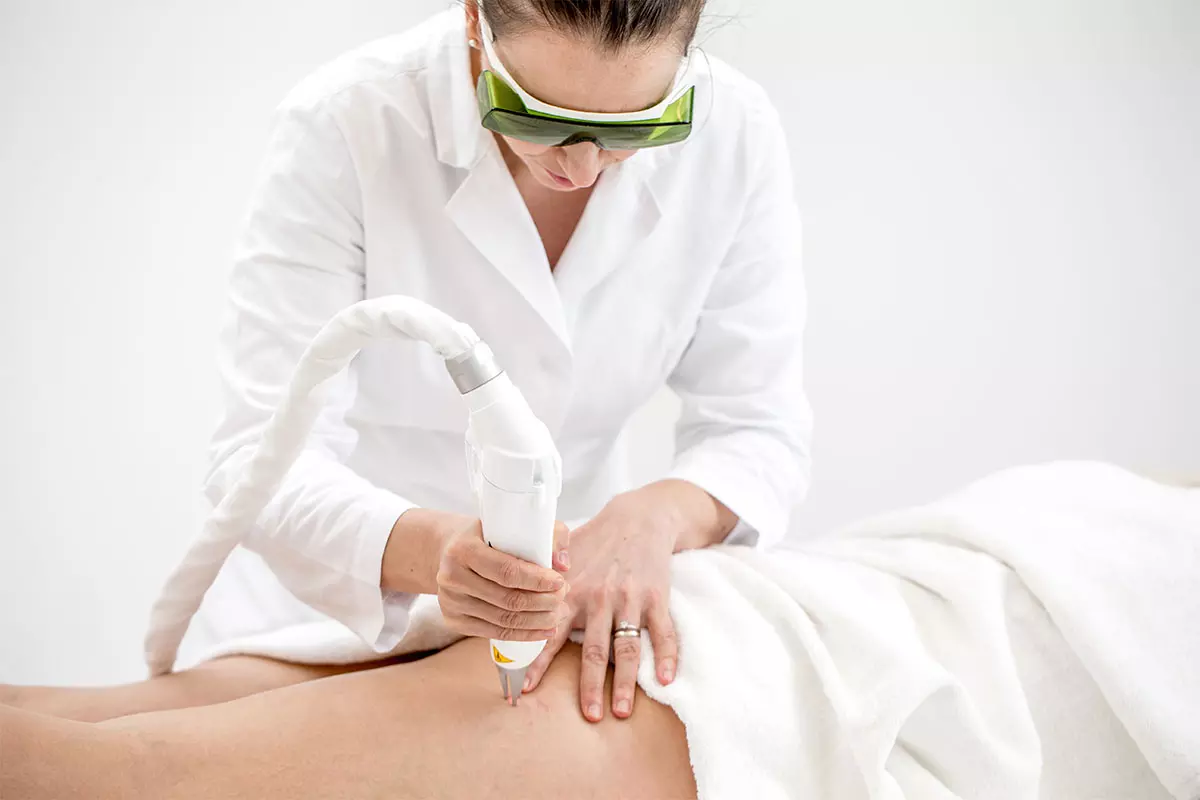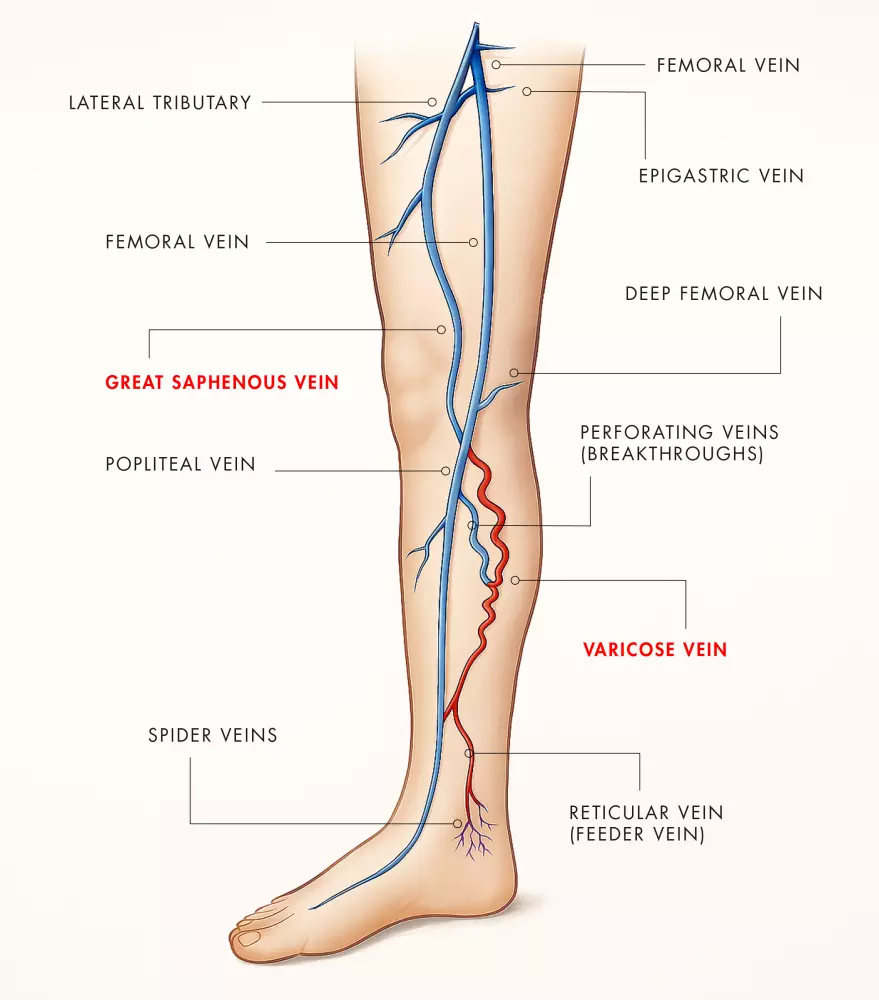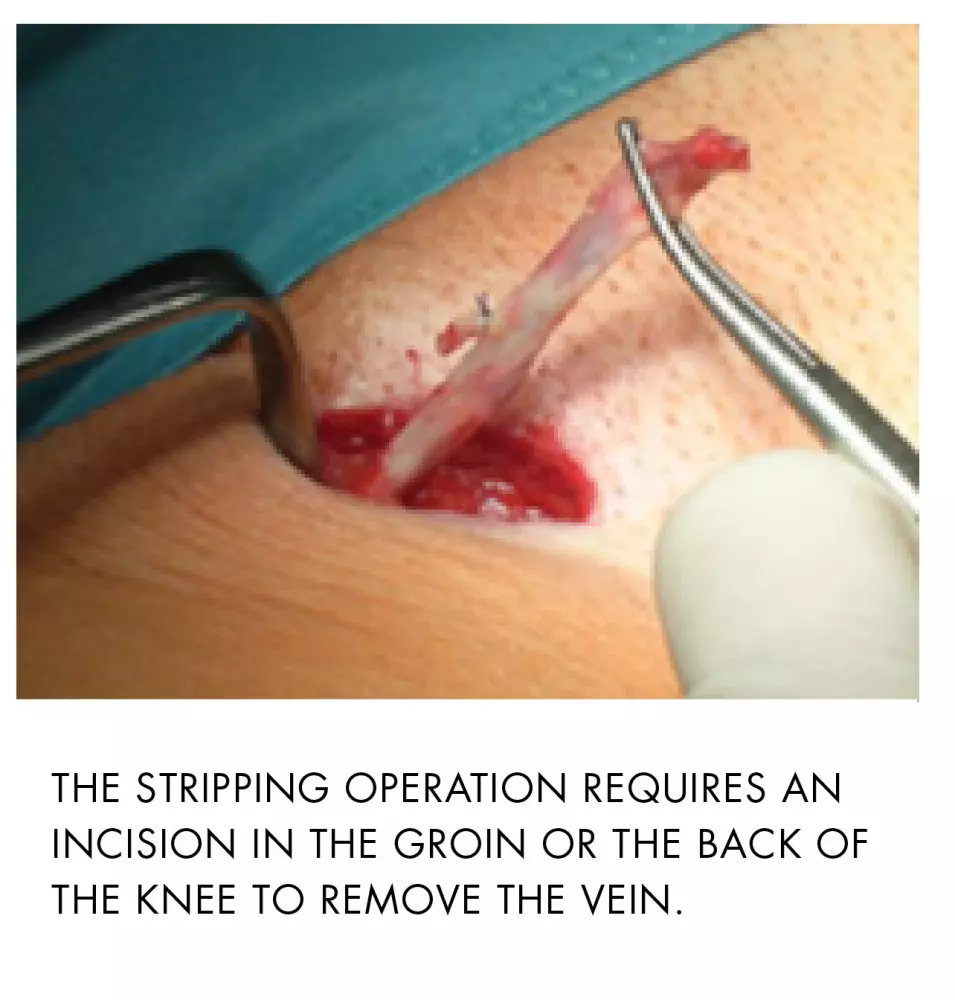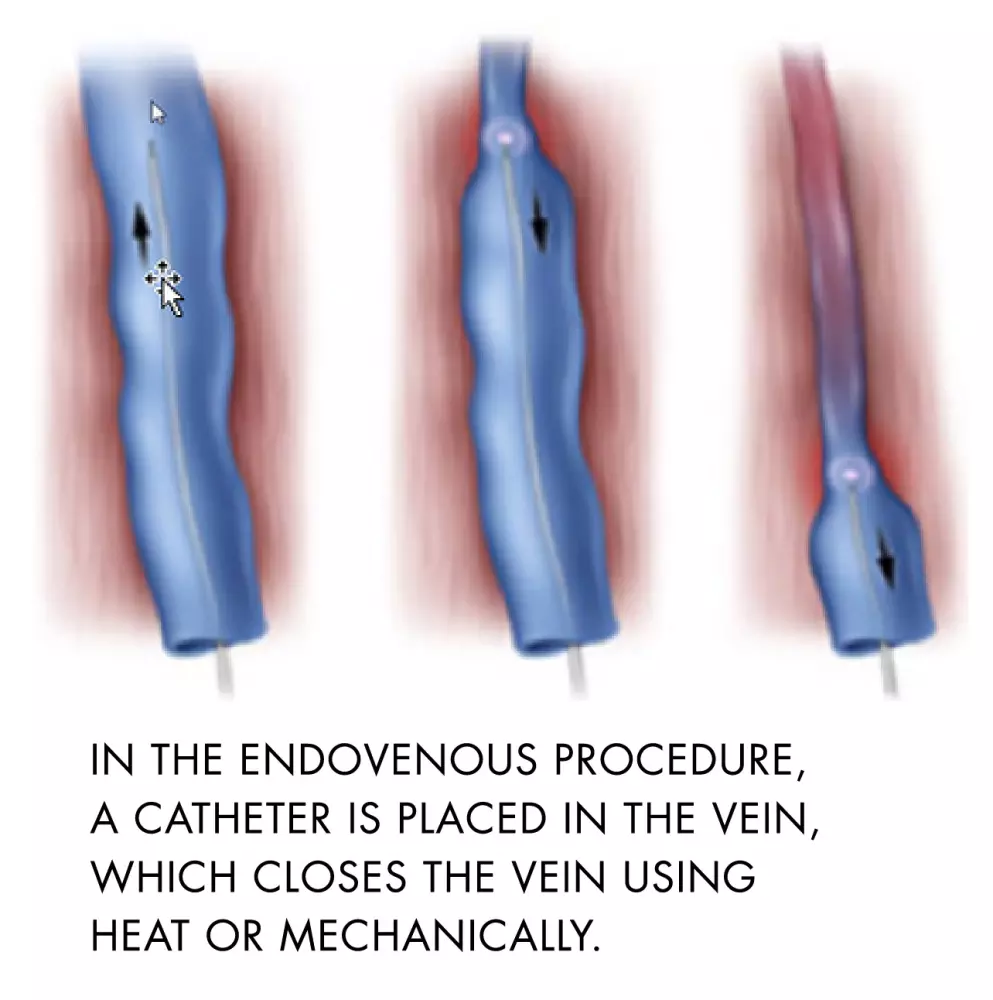Early detection of venous disorders: observe visible changes!
VENENCLINIC St. Gallen
9000 St. Gallen
VENENCLINIC Zurich
8004 Zurich
VENENCLINIC Chur
7000 Chur
VENENCLINIC Engadin
7513 Silvaplana

Dr. Linde has been working with this technique for over 12 years and has performed thousands of such procedures. Thanks to his many years of experience, he is able to treat ANY varicose vein with the laser, no matter how thick or tortuous it is. So far, there has never been a case where Dr. Linde has not been able to treat a varicose vein with the laser.
The term laser is short for Light Amplification by Stimulated Emission of Radiation. This refers to highly focused light which, depending on the laser medium, has a certain wavelength of high energy. The medium can be a gas such as argon, carbon dioxide (CO2), a crystal such as ruby or an electrical medium such as diodes.
Depending on the treatment objective, a very specific laser with a precisely selected wavelength is required, which can then usually only treat one problem. For example, the laser treatment of large veins requires a different device than the treatment of spider veins. We use state-of-the-art diode lasers with wavelengths of 1470 nm, 980 nm and 810 nm; we also have Nd:YAG and an IPL flash lamp for treating spider veins.
Patients usually come to us because of visible, tortuous veins on the leg – varicose veins or spider veins. These lead to symptoms such as leg swelling, a feeling of congestion, heavy legs and itching. Over the course of many years, these varicose veins can cause changes to the skin on the leg, even leading to a venous leg ulcer; these increasing changes are called "chronic venous insufficiency". Many patients also wish to have the visible varicose veins removed for aesthetic reasons.
However, what is visible on the leg is only "the tip of the iceberg". The inflow that causes these tortuous veins comes from veins that lie deeper under the skin and are rarely visible.

These usually include the great saphenous vein (Vena Saphena Magna, see illustration) and the small saphenous vein (Vena Saphena Parva). In order to eliminate the visible tortuous varicose veins, the inflow via these veins must be interrupted. This usually extends from the point where the tortuous veins are visible to the groin (large saphenous vein) or to the back of the knee (small saphenous vein).
There are various ways of eliminating these feeding veins. One method that is still frequently used – albeit outdated – is the so-called surgical stripping operation. Stripping consists of inserting a fine probe into the vein in the groin or the back of the knee and leading it out at the other end of the diseased section of vein on the lower leg and tying it to the veins. The entire vein to be eliminated can then be pulled out with the probe and completely removed.

Scientific studies have shown that new – so-called endovenous – procedures can now replace operations such as stripping. These minimally invasive methods do not require anesthesia or surgery, and incisions are no longer necessary. The veins are now obliterated and eliminated by inserting a catheter with laser heat (ELVeS™), radio frequency (VNUS Closure® ) or mechanically (ClariVein®) .
This puts hardly any strain on the body as the procedure can be performed under local anesthetic. The patient can return to work the very next day and there is no need to wear compression stockings.

It should be noted that these procedures can only eliminate the main vein feeding the vein; the tortuous and visible veins on the leg must then be removed using the hook technique.
This procedure can be compared to a blackbird pulling an earthworm out of the lawn. Through tiny micro-incisions, a hook is inserted through the skin into the subcutaneous fatty tissue where the vein runs.
The vein is grasped with the hook, pulled out visibly to the outside and then torn off under the skin. Another micro-stitch is made to access the subcutaneous fatty tissue again and the next part of the vein is removed... and so on. In this way, it is also possible to remove large sections of vein without leaving incisions and/or scars. The micro-incisions are only 1-2 mm in size. They heal so quickly and invisibly that it is possible to shower the very next day.
The ELVeS™ (Endo Laser Vein System) technology makes it possible to treat (very) large varicose veins on the leg in a minimally invasive and outpatient procedure under local anesthesia with excellent, scar-free, aesthetic results. The patient can go home immediately after the procedure and return to work the next day. Proprietary modifications of the endoluminal ELVeS™ method allow the bandages required immediately after the procedure to be removed the very next day. There is no need to wear compression stockings. No further treatment is necessary.
ELVeS™ (Endo Laser Vein System) technology for the treatment of varicose veins is the new standard for all vein procedures. This refers to the treatment of diseased, extensive varicose veins into which a laser fiber is inserted. The laser heat in the vessel then causes the vein to shrink, so that blood can no longer accumulate in it. There is no need to tear it out surgically. The laser procedure is therefore considerably less traumatic for the tissue and is no comparison to conventional surgery.
Large to very large varicose veins on the leg can now be treated minimally invasively on an outpatient basis under local anesthesia with excellent scar-free aesthetic results. The ablation takes about an hour and is practically painless, only the local anesthetic is a little uncomfortable. The patient can go home immediately after the procedure and return to work the next day. Thanks to a specially developed concept, it is possible to remove the bandages required immediately after the procedure the very next day. There is no need to wear compression stockings.
According to a survey in our center, well over 90% of patients would have the procedure performed again immediately. The latest studies with follow-up reports over 10 years clearly show that the durability of this method is more than proven. Various experts and international quality circles now classify this procedure as at least as good as conventional surgery or even better. Unfortunately, this method cannot prevent the recurrence of (other) varicose veins, but the percentage of new varicose veins is lower than with normal surgery.
Laser energy is a gentle and effective treatment method. Ablation of the large truncal vein using the ELVeS™ method is performed under local anesthesia (local tumescent anesthesia, no narcosis or spinal anesthesia) and takes 60-90 minutes in total. The procedure is almost painless, only the application of the local anesthetic is a little uncomfortable. For this reason, we perform the procedure in a very light twilight sleep. The patient is not allowed to drive on the day of the operation, but must use public transport or arrange to be picked up. Immediately after the procedure, the patient feels fit and can/should walk again. The gentleness of the method means that older people or patients with illnesses such as heart disease can also be treated with minimal risk.
First, the varicose vein pattern on the leg is outlined using ultrasound. Then, under ultrasound guidance, a cannula – and via this the catheter – with the laser glass fiber is inserted. The exact position of the laser fiber is then checked using ultrasound and the position is fixed. The local anesthetic is then injected under the skin where the varicose veins are to be treated. This only takes a few minutes. After a short exposure time, the actual laser treatment begins. The laser fiber is slowly withdrawn while a laser pulse is emitted every 1-2 seconds. This leads to massive heat in the vein so that the vein shrinks – comparable to a piece of meat in a hot pan. This takes about 5-10 minutes and is painless.
The result: The vein is only as thick as a piece of spaghetti and no longer has an opening through which the blood can flow incorrectly. It is closed – forever. After the laser treatment, the side branch varicose veins are then removed using the hook method (phlebectomy).
The ELVeS™ PainLess technology is a brand new addition, which uses a specially developed fiber that emits the laser light in a circular pattern and thus achieves better shrinkage of the vein wall. Depending on the case and the patient's wishes, the regular ELVeS™ system or the radial PainLess fiber is used.
We generally treat small varicose veins (spider veins) with foam sclerotherapy; laser light is only used in special cases. In contrast to endoluminal laser treatment (ELVeS™), the laser light is emitted onto the skin from the outside rather than from the inside when treating spider veins. New laser systems such as IPL lamp technology and the pulsed Nd:YAG laser have a wavelength that specifically reaches the red pigment of the small veins. Due to the special accumulation of light energy, the laser pulse causes the blood in the small vessels to heat up and the vein walls to contract – the spider veins disappear. While this treatment is very successful for dilated vessels, for example on the face, it often takes several sessions on the leg before a satisfactory result is achieved. In the case of spider veins, it is also important to carry out a preliminary assessment using color-coded duplex sonography to rule out invisible, internal, insufficient, large vein trunks – so-called "internal varicose veins". Such veins must then be treated and closed for the time being in order to prevent the rapid recurrence of spider veins.
The side effects of endoluminal procedures are similar to those of conventional vein operations. Slight discomfort, more or less visible bruising, hardening under the skin for a few days as well as irritation of small skin nerves (can cause the skin to feel slightly different than before) are typical. However, the laser procedure is significantly less destructive to the surrounding tissue than conventional vein surgery, which is why these side effects only occur very rarely.
In some cases, after treatment with the ELVeS™ method, there is a slight pulling sensation along the shrunken vein on the thigh. This often only occurs after 7-10 days. This is a process that accompanies the natural breakdown. You can continue your normal activities immediately, there is no danger and a few days later the discomfort will have disappeared.
In very rare cases (approx. 1-2%), the shrunken vein may reopen and blood may accumulate in it again. In such cases, the ELVeS™ procedure must be repeated. Thromboses and embolisms have been described in individual cases, but have never occurred in our case. However, a completely new thrombosis prevention method without injections protects you from this, which you carry out for 10 days.
We understand that an aesthetic treatment needs to be carefully considered. We are therefore happy to take the time to answer all your questions during a no-obligation initial consultation. Arrange your consultation appointment at one of our VENENCLINICs today.
If you would like a brief online preliminary clarification before your consultation, you can also contact us by e-mail.
No matter which way you want to contact us - we look forward to hearing/reading from you!